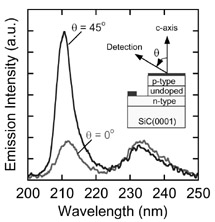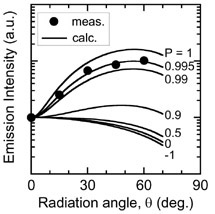@
Materials Science Laboratory
@ Aluminum nitride (AlN) is a direct-bandgap semiconductor with a bandgap
energy of 6 eV, the largest among semiconductors, and is therefore promising
for light-emitting devices with the shortest wavelength. We have succeeded
in p-type and n-type doping of AlN and have fabricated an AlN light-emitting
diode (LED). In this study, to gain insight into the light emission mechanism,
we characterized the radiation properties.
@ An AlN LED was grown on SiC (0001) substrate by metalorganic vapor phase
epitaxy. Figure 1 shows the radiation properties of the AlN LED. The radiation
angle Ę is defined as the angle from the surface normal (c-axis direction)
to the detection direction. As the radiation angle increases, the intensity
of the near-band-edge emission at 210 nm increases. To clarify the reason,
we analyzed the relationship between the emission intensity and the radiation
angle as shown in Fig. 2. Solid lines are calculated results for different
polarization ratios P. P = 1 corresponds to polarized light parallel to
the c-axis (E||c), P = |1 corresponds to polarized light perpendicular
to the c-axis (EŪc), and P = 0 corresponds to unpolarized light. The experimental
values follow the calculated one for P = 0.995. This indicates that the
emission strongly polarizes for E||c. As a result, the emission intensity
has the maximum perpendicular to the c-axis and the minimum parallel to
it. Therefore, as the radiation angle increases from the c-axis, the emission
intensity increases as shown in Fig. 1 [1].
@ The origin of the strong polarization can be explained by the band structure.
Because AlN has strong ionicity, the lattice is strongly distorted. As
a result, the crystal-field splitting energy has a negative value and the
top valence band therefore becomes the C7V band. A transition between the top valence band C7V and conduction band C7C is allowed for E||c but is almost completely prohibited for EŪc. Therefore,
the near-band-edge emission strongly polarizes for E||c. Using a crystal-field
splitting energy ¢CRY = 230 meV and a spin orbital splitting energy ¢SO = 20 meV, P was calculated to be 0.997, which is in good agreement with
the experimentally obtained value. Thus, we found that the strong polarization
results from the negative crystal-field splitting energy.
@ This work was partly supported by Grant-in-Aid for Young Scientists
(A), 19686003, from the Ministry of Education, Culture, Sports, Science
and Technology, Japan.
[1] Y. Taniyasu, M. Kasu, and T. Makimoto, Appl. Phys. Lett. 90 (2007) 261911.
 |
@ |  |
||||
|
|